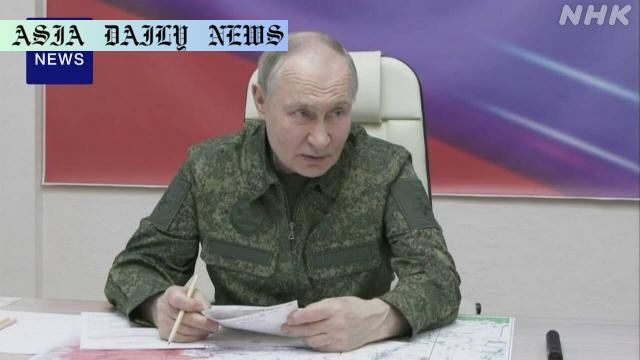Kursk stands at the center of intensified conflict as Putin orders swift action to reclaim all occupied territories.
- Putin visits Kursk, emphasizing swift recapture of all occupied areas.
- 86% of the previously seized land in Kursk reclaimed by Russian forces.
- Ukraine’s strategic repositioning aims to protect soldier lives and retain leverage.

Intensified Military Engagement in Kursk
Russian President Vladimir Putin has taken a decisive step with his visit to the Kursk region, marking a significant turning point in the ongoing conflict between Russia and Ukraine. Dressed in military attire, Putin’s presence emphasized the importance of swiftly reclaiming all occupied territories within the Kursk region—a key location embroiled in the current clashes. As reported, approximately 86% of the contested areas have been recaptured by Russian forces, highlighting their aggressive push to establish dominance and restore control. This development comes amidst continued resistance from entrenched Ukrainian forces who hold on to strategic strongholds within the area.
Strategic Implications of Kursk’s Liberation
The Kursk region, situated along the western Russian border, has emerged as a crucial focal point for both nations. For Russia, liberating this territory is viewed not only as a milestone in the ongoing military campaign but also as a matter of national sovereignty. Putin’s direct order to expedite the removal of Ukrainian forces underscores the Kremlin’s intent to consolidate power and stabilize its border regions. Furthermore, the city of Sudzha, a critical area within Kursk, has already been reclaimed—a key victory for Moscow. However, Ukrainian resistance remains formidable. As per Ukrainian military commander Oleksandr Syrskyi, ongoing clashes continue in and around Sudzha, with his forces maneuvering tactically to protect their soldiers and preserve their negotiating leverage.
Ukraine’s Tactical Maneuvers
From the Ukrainian perspective, holding parts of the Kursk region serves more than a defensive purpose. Kyiv sees the occupied territories as a bargaining chip in potential future negotiations. Ukrainian forces have therefore adopted a strategy of cautious repositioning, prioritizing the safety of their troops while maintaining their capacity to counterattack when opportunities arise. This approach, while pragmatic, could face challenges as Russian forces intensify their operations. Losing significant footholds in Kursk would not only be a tactical setback for Ukraine but could also weaken its leverage on the diplomatic table.
Broader Impacts of the Kursk Conflict
The unfolding developments in Kursk have far-reaching implications, not just for the involved parties but also for the international community observing the conflict. Should Russia achieve total control over the region, it would bolster Moscow’s standing and likely embolden its approach to other contested areas. Conversely, Ukraine’s struggle reflects the broader challenges of balancing military resilience with strategic compromise. In addition, the conflict continues to strain the relations between Western allies supporting Ukraine and an increasingly isolated Russia. The ongoing battles in Kursk serve as a reminder of the human cost of prolonged warfare, with civilians in contested areas facing displacement, uncertainty, and potential humanitarian crises.
Looking Ahead
The coming weeks are expected to bring heightened military activity in the region as both sides vie for control. Russia’s focus on swift and decisive action could lead to intensified confrontations, while Ukraine’s adaptive strategies suggest a protracted conflict. For international observers, the Kursk conflict offers a microcosm of the larger geopolitical struggles unfolding in Eastern Europe. As tensions escalate, the importance of diplomatic channels and conflict resolution mechanisms grows ever more urgent. Whether Kursk becomes a symbol of domination or defiance remains to be seen, but its unfolding narrative will undoubtedly shape the trajectory of this ongoing turmoil.



Commentary
Kursk’s Strategic Importance and the Road Ahead
The recent developments in Kursk underscore the region’s pivotal role in the broader conflict between Russia and Ukraine. President Vladimir Putin’s visit sent a strong signal of prioritization and determination, further highlighting the Kremlin’s intent to fully reclaim the area. Kursk, as both a geopolitical and symbolic location, has turned into a hotspot for military maneuvers and strategic planning. The recapture of Sudzha demonstrates Russia’s expanding grip over the region, but the continuing skirmishes reveal the resilience of Ukrainian forces.
Ukraine’s Tactical Resilience
On the Ukrainian side, the decision to reposition troops for tactical advantage reflects a pragmatic approach by their military command. While some may view this as a retreat, it is more likely a calculated strategy to minimize losses and hold on to valuable leverage for potential negotiations. Ukraine’s efforts to turn the occupied areas into bargaining tools are a testament to their resourceful military and political strategies. However, it is uncertain how sustainable this approach will be, especially as Russian forces ramp up pressure in the region.
The Need for Global Attention
As the battle for Kursk intensifies, it is crucial for the international community to monitor this development closely. The region’s fate could set the tone for future conflicts in Eastern Europe. Diplomatic interventions and support for affected civilians should be prioritized to prevent further escalation. The crisis in Kursk serves as a stark reminder of the ongoing volatility in the region and the enduring challenges of achieving lasting peace.